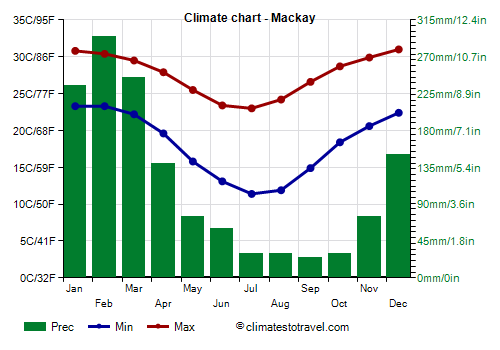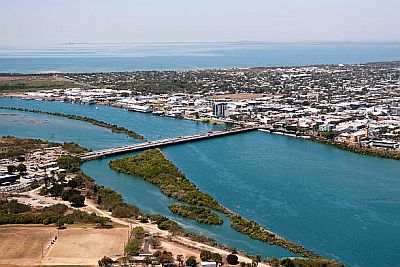Select units of measurement for the temperature and rainfall tables (metric or imperial).
Average weather, temperature, rainfall, sunshine hours

The climate of Mackay is
humid subtropical, very mild to pleasantly warm, sunny winters (from June to August) and hot, muggy summers (from December to March). The rains are abundant from January to March, but in some years they are also abundant in November, December and April.
Being in the southern hemisphere, the seasons are reversed compared to the northern hemisphere.
The city is located on the northeastern coast of Australia, in Queensland, at 21 degrees south latitude. About 70 km (43 mi) to the west, in a hilly area, is the
Eungella National Park. To the north are the
Whitsunday Islands, while on the mainland near these islands is
Conway National Park. Off the coast is instead the
Great Barrier Reef.

Winter, from June to August, is very mild, however,
cold air can sometimes arrive from the south and lower the temperature, especially at night, when it can drop below 5 °C (41 °F). In June 2007 it dropped to 0.7 °C (33.3 °F). The record is as low as -0.4 °C (31.3 °F), even though it dates back to July 1951.
In spring, starting in September,
heat waves can occur, with highs of 35 °C (95 °F) and more. The highest record is 39.7 °C (103.5 °F) and was set in late November 2018.
In summer, with frequent rains and high humidity, heat waves are a little rarer, however, from January to March the temperature can reach 35/36 °C (95/97 °F).
This north-central area of Queensland can be affected by
tropical cyclones. Cyclones typically form from mid-November to mid-May, but are more likely from January to March. A particularly intense cyclone hit the city in January 1918. Other less intense cyclones passed in early March 1955, in January 1970 (Ada), on March 20, 2010 (Ului) and in late March 2017 (Debbie).
Best Time
To visit Mackay you can choose the relatively cool period,
from May to September, which is also the driest of the year.
The
sea is warm enough for swimming even in this season, however, it can sometimes get a little cool at night, so the month of October may be preferred for a beach holiday.
Mackay - Climate data
In Mackay, the
average temperature of the coldest month (July) is of
17.2 °C, that of the warmest month (January) is of
27 °C. Here are the average temperatures.
Mackay - Average temperatures (1991-2020) |
| Month | Min | Max | Mean |
|---|
| January | 23.3 | 30.8 | 27 |
|---|
| February | 23.3 | 30.4 | 26.8 |
|---|
| March | 22.2 | 29.5 | 25.8 |
|---|
| April | 19.6 | 27.9 | 23.8 |
|---|
| May | 15.8 | 25.5 | 20.6 |
|---|
| June | 13.1 | 23.4 | 18.2 |
|---|
| July | 11.4 | 23 | 17.2 |
|---|
| August | 11.9 | 24.2 | 18 |
|---|
| September | 14.9 | 26.6 | 20.8 |
|---|
| October | 18.4 | 28.7 | 23.5 |
|---|
| November | 20.6 | 29.9 | 25.2 |
|---|
| December | 22.4 | 31 | 26.7 |
|---|
| Year | 18 | 27.6 | 22.75 |
|---|
amounts to
1380 millimeters per year: it is therefore quite abundant. It ranges from
25 millimeters in the driest month (September) to
295 millimeters in the wettest one (February). Here is the average precipitation.
Mackay - Average precipitation| Month | Days |
|---|
| January | 235 | 12 |
|---|
| February | 295 | 14 |
|---|
| March | 245 | 12 |
|---|
| April | 140 | 10 |
|---|
| May | 75 | 8 |
|---|
| June | 60 | 6 |
|---|
| July | 30 | 3 |
|---|
| August | 30 | 3 |
|---|
| September | 25 | 2 |
|---|
| October | 30 | 4 |
|---|
| November | 75 | 6 |
|---|
| December | 150 | 9 |
|---|
| Year | 1380 | 88 |
|---|
The
sea temperature ranges from
21 °C in July, August to
28 °C in January, February. Here are the average sea temperatures.
Mackay - Sea temperature| Month |
|---|
| January | 28 |
|---|
| February | 28 |
|---|
| March | 27.5 |
|---|
| April | 26.5 |
|---|
| May | 24.5 |
|---|
| June | 22.5 |
|---|
| July | 21 |
|---|
| August | 21 |
|---|
| September | 22 |
|---|
| October | 24 |
|---|
| November | 25.5"> |
|---|
| December | 27 |
|---|
| Year | 24.9 |
|---|